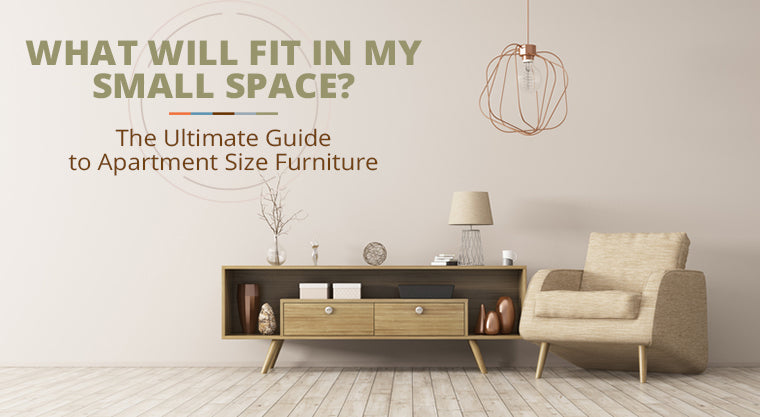When you’re working with limited floorspace, you know you need to scale down. Minimizing in terms of furniture size doesn’t mean you have to minimize in terms of style. Designing a tasteful, functional and well laid-out room comes down to choosing the right apartment size furniture and knowing how to style it. Whether you’re looking to turn your living room into a multifunctional guest suite or to optimize a studio apartment so you can entertain a crowd, we’re here to help you with everything you need to know about shopping for apartment size essentials.
As with any design endeavor, taking a little bit of time to understand your options and outline your specific goals will help you achieve the perfect design for your apartment, loft or tiny house. Before you begin, draw up a rough sketch and an idea of what you’d like to include in your small space. Do you want enough seating for a small gathering, or would you rather have a cozy dining nook? Know that just because you must compromise a bit on size, doesn’t mean you have to give up style or comfort. Today’s high-end furniture makers design custom and quality small apartment furniture that ticks all of your boxes, size and other requirements.
What Qualifies as Apartment Size Furniture?


The first thing you need to know when shopping for small space furniture is, well…it’s small! But an apartment size sleeper sofa or loveseat may not be labeled as such, so knowing a thing or two about dimensions certainly helps. In general, apartment size furniture is smaller than full-size furniture in length and width. Sometimes, to maintain proportion, apartment size pieces are also cut short in the height department. Here’s how apartment size furniture stacks up to regular size furniture:
- Sofas — Regular size three-seat sofas typically measure about 35 inches deep by 84 inches wide, while apartment size sofas are usually measuring somewhere between 68 and 80 inches wide, with a few inches shaved off to save space in depth. Unlike apartment loveseats, apartment sofas usually still feature three seats.
- Sectional Sofas — Regular sectional sofas vary in size, with five-seat sectionals featuring about 95 inches of width in total and a depth of up to 40 inches. An apartment size sectional sofa, however, could be as small as 80 inches wide by 35 inches deep.
- Loveseats — Loveseats and chaise lounges are naturally good options for smaller spaces, with standard styles measuring somewhere around 60 inches wide by 35 inches deep. If you’d like an apartment size loveseat to complement your apartment size sofa, look for one that measures around 53 inches wide by 35 inches deep.
- Accent Chairs — A typical armchair measures 35 inches wide by 35 inches deep or somewhere in that arena. You can go as small as you’d like on accent chairs, with comfortable styles measuring as little as 25 inches wide. Our Marla Contemporary Modern Swivel Accent Chair is the perfect small chair option that still offers style.
- Coffee Tables — You’ll also want to make sure you consider coffee table sizing to ensure good balance and proportion. A typical coffee table measures about 30 inches wide by 48 inches long, while apartment-friendly varieties may be as small as 24 inches long.
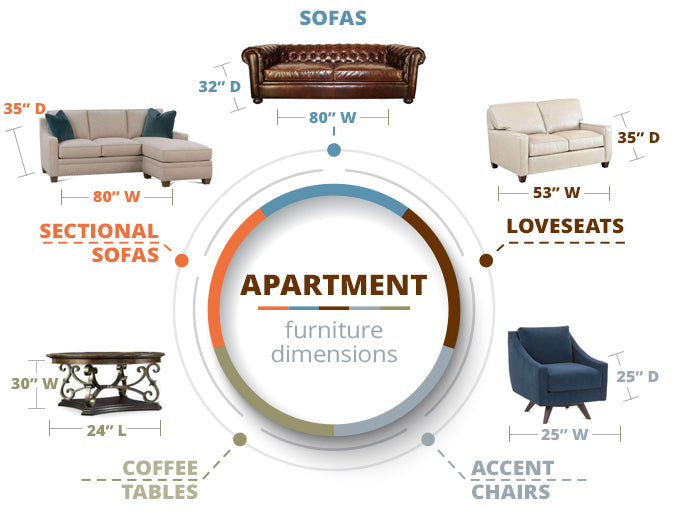
Measuring 101

Whether you’re picking out furniture for a vast, open living room or a teeny-tiny abode, the end game is the same, you want a room that feels comfortable and roomy, even when you’re entertaining. To ensure that every square inch of your space is well-used, you must start with the basics. Measuring your space before you choose your main pieces of apartment size furniture—sofas, loveseats, accent chairs and tables—is key to ensuring proper furniture sizing.
Why measure? Interestingly, it isn’t always the size of the furniture that makes a room feel small. It’s often scale, proportion and how much space is left between each piece, which can often times cause an overcrowded feeling. When you get proper measurements and can lay out the room beforehand, you’ll be able to leave room between pieces, and prevent the feeling that one piece of furniture is too big for the rest of the space.
So how do you measure a room for furniture? First, measure the length of the walls, taking into account any breaks for doorways, windows, permanent appliances and any other architectural features that may affect the way you position your pieces. Next, use the dimensions to sketch out a visual floor plan. There are some great apps and tools online that will help you visualize your space based on your room’s measurements. We like MagicPlan for this. You will also want to measure the height of the windowsill, making sure to pick pieces that don’t go much higher.
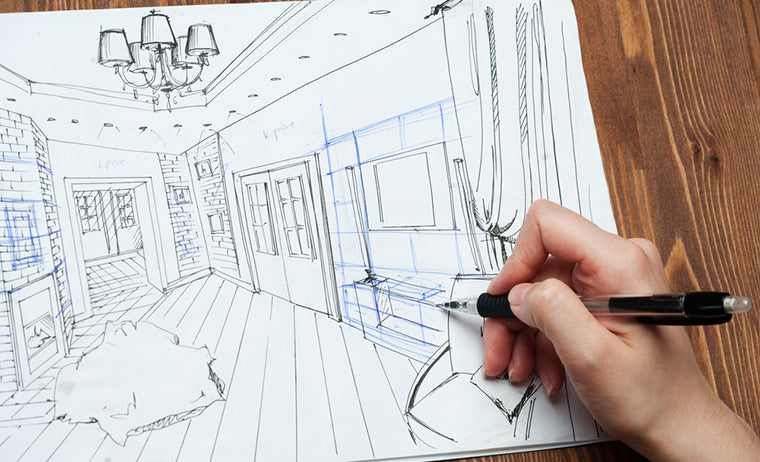
If possible, think about which pieces you pick with regard to scale. In other words, try to choose all your apartment sized furniture by how each piece looks next to each other and in the big picture of the room. A loveseat and a sofa shouldn’t be the same size, even if they both fit nicely in a room. On the same token, you don’t want an oversized coffee table with a relatively compact couch. Make sure that all of your apartment sized furniture works well together, in terms of design and sizing.
Arranging 101

The next piece of the small space décor puzzle is arranging. When you have relatively little space to work with, your arrangement opportunity is probably rather limited. However, you can still use some simple tricks to help you create a nice room flow and ensure that you get good use out of every square inch of living space. Remember, the layout of your room dictates the course of the room and can also help shed light on its best features, like window views and artwork.
The first thing to know when arranging is to make sure that you leave space in between pieces to ensure a good flow so you can easily pass from one side of the room to another. Try to leave roughly two feet of space between each piece of furniture so that you can move freely through the room. If you have enough room, consider creating a few areas—separating spaces with rugs or furniture groupings for an even more user-friendly living space.
Regardless of the size of your room, it’s important that you follow basic design principles when laying out your space. As obvious as it may be, do your best to avoid covering up any windows, doors or fireplaces, and try not to overcomplicate the design. Placing a sofa on a wall and grouping furniture in a way that makes sense conversation-wise—such as with a sofa positioned across from two accent chairs is always a good design choice. The takeaway? Trust your instincts!
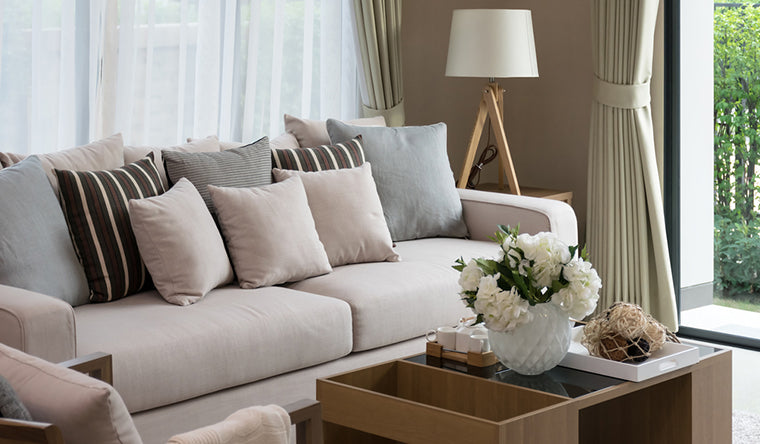
Small Room Design Tips

So, once you know what size furniture to look for and how to use it to your advantage in any given room, it’s time to consider your design approach. Small apartment furniture is unique in ways beyond its size, too. It often has other features that help you situate it nicely in more compact or challenging environments. Here are some great tips for decorating a small space, no matter your unique design goals.
- Think Small, But Not Simple — The best way to approach any small room design is, of course, to think small. But know that almost all types of furniture—from ultra-modern, minimalist sofas to luxurious, tufted leather sectionals—are available in more compact styles. Just because you need small doesn’t mean your options are limited. Choosing pieces that are big on texture and detail will help bring small spaces to life.
- Think Multifunctional — The best apartment size furniture designs are the ones that help you optimize space–not just by being small, but by helping you eliminate the need for other pieces of furniture. The apartment sleeper sofa is a fantastic example of a piece of furniture that doubles down on function. You can eliminate the space-hogging guest bed while increasing seating and style with the right pull-out sofa.a.
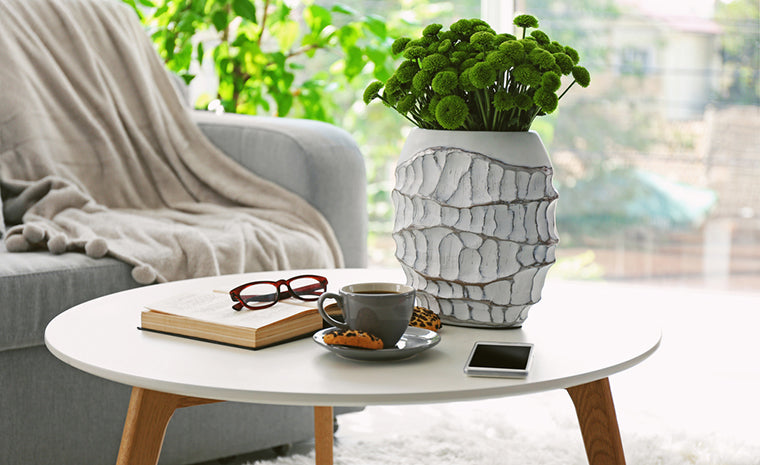
- Storage is Non-Negotiable — When you’ve got an especially small space, you may have to forego certain pieces, like hutches, buffets and entertainment centers. To make up for it, try your best to pick pieces that have extra storage built in. The easiest way to do this is through your tables. Pick coffee tables and side tables that have plenty of room for storing odds and ends to eliminate clutter.
- Choose Nesting Furniture — Another great way to get the most out of a compact space is to choose furniture that nests. A good set of nesting tables or a coffee table with built-in, removable seating allows you to place certain pieces out of the way when not in use and employ them when needed, effectively turning your main living space into one that always serves the appropriate purpose.
- Go Round, Not Square — One of the tips you can use when designing a small space is to do everything you can to avoid feelings of confinement or limitation. For that reason, we always recommend furniture with rounded edges including sofas with rolled arms, rounded coffee tables and circular swivel chairs, to help prevent the feeling of being boxed in. Tie it all together with a round area rug for added effect.
- Think About Color and Texture — In small spaces, it’s a good idea to pick furniture in lighter, airier color tones, especially soft neutrals, rather than deep browns, blacks or greens. You may also want to pick upholstery that’s similar in tone to your walls to create a limitless illusion. We always recommend going with companies that handcrafts their own furniture and offers free swatches so that you can see and feel the fabrics in person.
Getting Small Space Design Right

Finding the right furniture for a small space is sort of like Goldilocks’ endeavor. You have to find pieces that are not too big, not too small, but just right. At the end of the day, the best way to do this is to partner with a quality-focused furniture maker, like Club Furniture, that crafts furniture pieces specifically for apartments and smaller-sized homes. It helps if you pick a company that offers pieces in several different sizes. This way, you don’t have to compromise your preferred style to get sizing right.
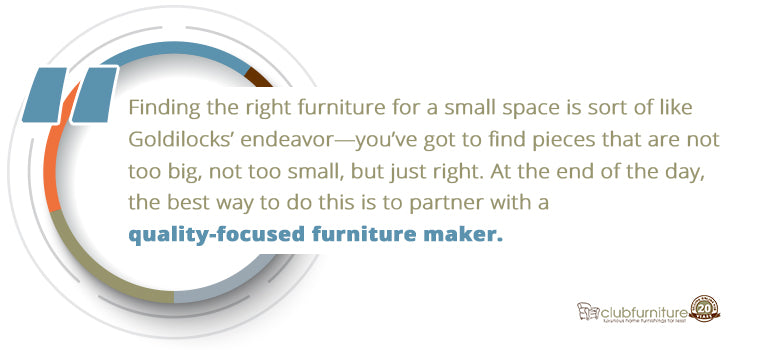
The next step is to do everything you can to visualize the space before you make any big investments. Using a floor plan app to mockup your room is a safe bet, as it will help you get the scale and sizing just right. Finally, do your best to shop with companies that prioritize customer service and offer solid warranties. If you partner with the right company, you’ll eliminate many risks that come with an apartment size furniture investment, and you know you can always rely on good customer care should anything go wrong.










